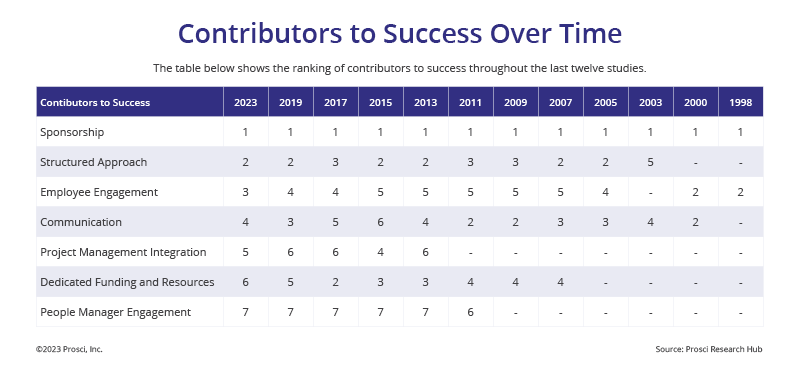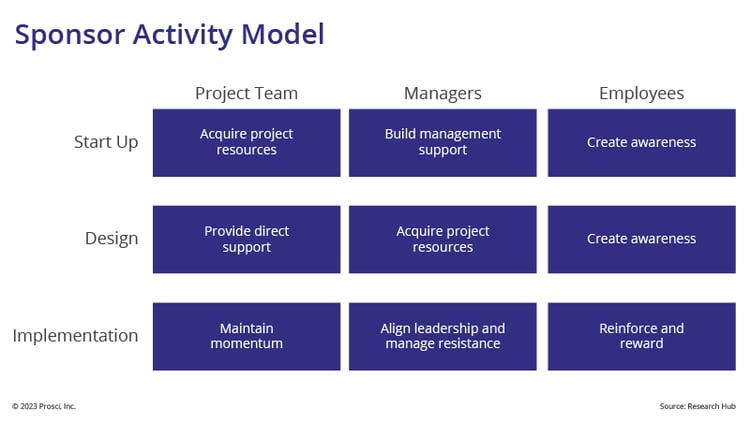5 Tactics for Engaging Effective Sponsors

3 Mins
Updated: October 25, 2023
Published: February 14, 2018

Change management practitioners play an important role in preparing, equipping and supporting executives for their roles during change. When practitioners do their job effectively, they become a vital partner in achieving successful outcomes. But how should you go about it? The practitioner insights below shares offer fresh perspectives and best practices for engaging executives and leaders in their sponsorship role, and helping them understand the activities that great change sponsors perform.
The 12th Edition of Prosci's Best Practices in Change Management research study revealed that initiatives with sponsors who did not adequately understand their roles correlated with much lower levels of successful outcomes form changes.
When the sponsor had a less-than-adequate understanding of their role, the project met or exceeded objectives only 35% of the time. By contrast, sponsors who had an adequate or complete understanding of their role met or exceeded project objectives 62% of the time.
Active and visible change sponsorship remains the number one success factor for creating successful change outcomes.

Most Effective Tactics for Creating
Active and Visible Sponsorship
Participants in this research identified five tactics for change managers to use to help leaders create active and visible sponsorship:
1. Provide behind-the-scenes assistance to the sponsor on their role
The most effective tactic reported by participants for creating active and visible sponsorship was assisting with action plans, scheduling activities and preparing materials for the primary sponsor. Efforts by the change management team included: developing a sponsor roadmap or action plan, involving the sponsor in hands-on work to show visible support, drafting sponsor communications (e.g., newsletters, emails), preparing talking points, scheduling or inviting the sponsor to meetings, and creating opportunities for the sponsor to be active and visible (e.g., town halls, roadshows, staff meetings and walk-arounds).
2. Coach the sponsor on their role
The second most common tactic for creating active and visible sponsorship is to explain the role of effective sponsorship, establish expectations for the role, and equip the primary sponsor with tools, advice and coaching to make their job as sponsor easy to fulfill. Participants also indicated that it is important to build trust and rapport with the sponsor to effectively enact this coaching.
3. Hold regular meetings
Engaging with the sponsor through regular meetings or communications was the third most common tactic. Activities during these meetings or correspondences included: discussing project updates and progress, reiterating key messages, asking and answering questions, sharing successes, and giving feedback on the sponsor’s involvement on the project.
4. Ensure the sponsor communicates directly with employees
Research participants indicated that ensuring that the sponsor communicates directly with employees (e.g., through face-to-face communications, live or recorded speeches, videos, written communication, etc.) is another tactic for having the sponsor actively and visibly engage in the change. This includes communicating the need for change across all levels of the organization and having personal discussions about the change with impacted employees.
5. Hold the sponsor accountable in their role
Study participants indicated that holding primary sponsors accountable and ensuring that they show support for the change management efforts were tactics for creating active and visible sponsorship. Suggestions included alignment to their personal interests, Key Performance Indicators (KPIs) or personal initiatives.
When formally evaluating the effectiveness of a sponsor, research participants used three methods:
- Clearly outlined objectives
- Observation and feedback
- Use of formal tools or methodologies
Sponsor Activity Model
Participants also described the most important types of activities a change sponsor can perform. The data was broken into three major project phases: start-up (planning), design and implementation. The activities and steps were further categorized by the primary target audiences:
- Project team
- Managers (including business leaders)
- Employees (or front-line stakeholders)
Prosci's Sponsor Activity Model illustrates the responsibilities sponsor's undertake during each project phase (start-up, design and implementation). The activities required for each box in this figure are intended to be general descriptions for the category.
 For each unique change project, change management teams should work together with sponsors to outline and agree on the specific sponsorship activities for sponsors to perform with each audience at each phase of the project. This checklist provides a simple framework to get started. More extensive lists of specific activities in each of the nodes of the model are available in Prosci’s Best Practices in Change Management report in Research Hub.
For each unique change project, change management teams should work together with sponsors to outline and agree on the specific sponsorship activities for sponsors to perform with each audience at each phase of the project. This checklist provides a simple framework to get started. More extensive lists of specific activities in each of the nodes of the model are available in Prosci’s Best Practices in Change Management report in Research Hub.
When it comes to implementing the Sponsor Activity Model, the change management team can enable the successful outcome of each activity by acting in a role similar to an executive assistant, scheduling events, preparing for the events and making sure the sponsor is fully prepared.
Learn More About Sponsorship
The resounding theme from more than two decades of best practices research is that executives and leaders play a pivotal role in change. Discover more about the role of a sponsor and how you can support your sponsor and create a sponsorship plan with this article on a sponsor’s importance and role. Use this Sponsor Start-Up Checklist as a starting place for planning sponsor activity, too.


